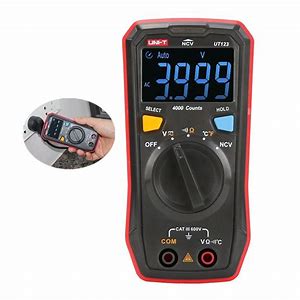
UNI-T Residential Multimeter User Manual
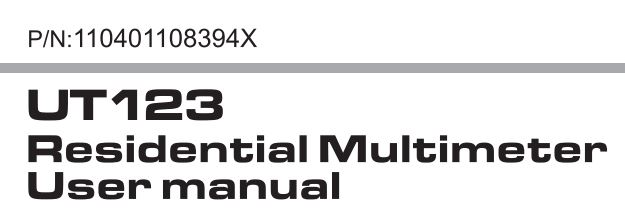
Preface
Thank you for purchasing the new UT123 residential multimeter. In order to use this product safely and correctly, please read this manual thoroughly, especially the Safety instructions.
After reading this manual, it is recommended to keep the manual at an easily accessible place, preferably close to the device, for future reference.
Limited Warranty and Liability
Uni-Trend guarantees that the product is free from any defect in material and workmanship within one year from the purchase date. This warranty does not apply to damages caused by accident, negligence, misuse, modification, contamination and improper handling. The dealer shall not be
entitled to give any other warranty on behalf of Uni-Trend. If you need warranty service within the warranty period, please contact your seller directly.
Uni-Trend will not be responsible for any special, indirect, incidental or subsequent damage or loss caused by using this device. As some countries or regions do not allow limitations on implied warranties and incidental or subsequent damages, the above limitation of liability may not apply to you.
1. Overview
The UT123 is a pocket-size residential multimeter specially designed for home use. The compact structure makes it easy to hold in one hand, and the EBTN screen allows users to obtain clear readings at maximum angle. The multimeter is designed according to EN61010-1 :2010, EN61010-2-030:2010, and EN61326-1 :2013 safety standards and is able to safely operate within the CAT Ill 600V environment.
2. Features
- The battery status detection is automatically completed at the moment of booting: The green light indicates the normal state; the yellow light indicates low battery; the red light indicates very low battery, and there is acousto-optic indication at this time.
- Automatic identification of ACV/DCV measurement
- Intelligent non-contact electric field detection, which distinguishes the weak electric field by green light, the strong electric field by yellow light, and the super strong electric field by red light
- Full featured protection .

3. Safety Instructions
- Do not use the meter if the rear cover is not covered up, or it will pose a shock hazard!
- Before use, please check and make sure the insulation layer of the meter and test leads is in good condition without any damage or broken wires. If you find the insulation layer of the meter housing is significantly damaged, or if you think the meter cannot function property, do not use the meter.
- When using the meter, your fingers must be placed behind the finger guard ring of the test leads.
- Do not apply voltage over 600V between any meter terminal and earth ground to prevent electric shock and damage to the meter.
- Be cautious when the measured voltage is higher than 60V (DC) or 30Vrms (AC) to avoid electric shocks
- The measured signal is not allowed to exceed the specified limit to prevent electric shock and damage to the meter!
- The range switch should be placed in the corresponding position during measurement.
- Never change the range setting when measuring to avoid damage to the meter!
- Do not change the internal circuit of the meter to avoid damage to the meter and user!
- When the

- Do not use or store the meter in high temperature and high humidity environments. The performance of the meter may be affected.
- Clean the meter casing with a damp cloth and mild detergent. Do not use abrasives or solvents!
- Safety symbol description

4. Operating Instructions
- The meter has the function of battery self-checking, and can complete the battery status detection within 2 seconds at the moment of booting:
a) When the supply voltage is >2.7V, the indicator on the top of the meter lights up green for 2 seconds, indicating that the power is sufficient, and the meter enters the normal measurement mode accompanied by one beep.
b) When the supply voltage is within 2.4V~2.7V, the indicator on the top of the meter lights up yellow, and the low battery symbol
c) When the supply voltage is <2.4V, the indicator on the top of the meter lights up red for 2 seconds, and then the meter powers off. It can only be used after replacing the batteries.
4.1 DC/AC Voltage Measurement (Picture 1)
1) Tum the range switch to the AC voltage position;
2) Insert the red test lead into the ” v Ω
3) Read the test results on the display.
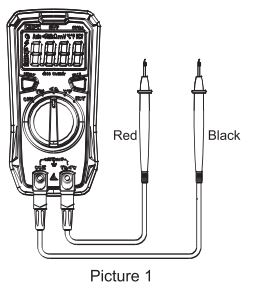
The meter has the function of ACV/DCV automatic Identification (voltage ~ 0.5V). If you want to measure voltage less than 0.5V, press the SELECT button to toggle the AC and DC voltage to lock the measurement mode; After pressing the SELECT button, the meter no longer has the function of ACV /DCV automatic Identification, unless you turn the range switch or restart the meter

* Do not measure voltage above 600Vrms. Although it is possible to measure higher voltage, it may damage the meter and hurt the user! If the LCD displays “OL”, ii indicates that the voltage is over range. The input impedance of the meter is 10MΩ. This load effect may cause measurement error when measuring high impedance circuits. If the measured impedance is ≤10kΩ, the error can be ignored (~0.1%).
* Be cautious to avoid electric shock when measuring high voltage.
* Test known voltage before use to confirm if the meter functions properly!
4.2 Resistance Measurement (Picture 1)
- Tum the range switch to the resistance measurement position;
- Insert the red test lead into the “v Ω

- Read the test results on the display.

- Before measuring the online resistance, switch off the power supply of the circuit, and fully discharge all capacitors to avoid damage to the meter and user.
- If the resistance is not less than 0.50 when the test leads are shorted, please check if the test leads are loose or abnormal.
- If the measured resistor is open or the resistance exceeds the maximum range, the “OL” symbol will appear on the display.
- Do not input voltage higher than DC 60V or AC 30V.
- Measured value = measured display value – short circuit value of the test leads
4.3 Continuity Measurement (Picture 1)
1) Turn the range switch to the continuity measurement position;2) Insert the red test lead into the ” VΩ 

• Before measuring the continuity online, switch off the power supply of the circuit, and fully discharge all capacitors to avoid damage to the meter and user.
4.4 Temperature Measurement (°C/°F Measurement, Picture 2)
1) Turn the range switch to the temperature measurement position;
2) Insert the plug of the K-type thermocouple into the meter, and fix the temperature sensing probe on the object to be tested; read the temperature value on the display after it is steady.

“OL” symbol appears when the meter is turned on. Only K-type thermocouple/ temperature sensor is applicable (The measured temperature should be less than 300 “C/572 ‘F). °F=°C*1.8+32
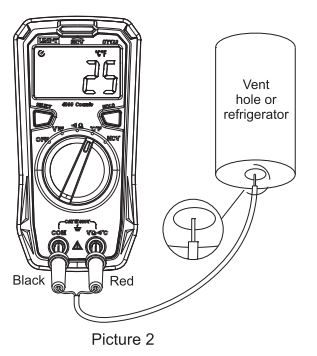
4.5 Non-contact AC Electric Field Sensing (Picture 3)
- To sense whether there is AC voltage or electromagnetic field, please turn the range switch to the NCV position;
- Bring the front end of the meter close to the measured object to start sensing. The intensity of the electric field sensing is indicated by the LED indicator and the segment “-” on the LCD. The more the segments (up to four segments) are displayed, the higher the electric field intensity and the faster the beep.
* During measurement, if there is no operation of the range switch or any button for 15 minutes, the meter will automatically shut down to save power. You can wake tt up by pressing any button or turning the range switch, and the buzzer should beep once for indication. To disable auto shutdown, tum the range switch to the OFF position, press and hold the SELECT button (~ 2 seconds) while power up the meter
- When you press any button or tum the range switch, the buzzer will beep once.
- Buzzer warning: Input voltage ~ 600V (AC/DC): The buzzer beeps continuously warning that the range is at its limit.
- About 1 minute before auto shutdown, the buzzer will make five consecutive beeps; before shutdown, the buzzer will make one long beep.
5. Specifications
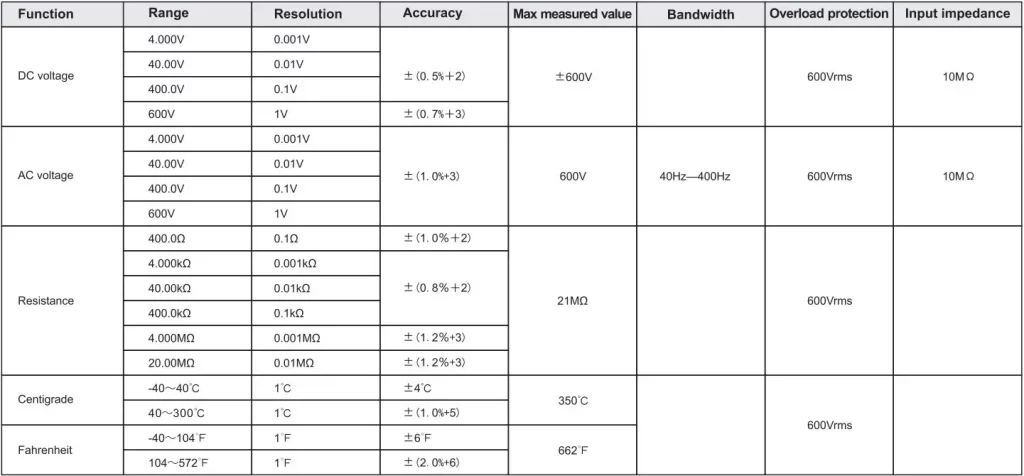

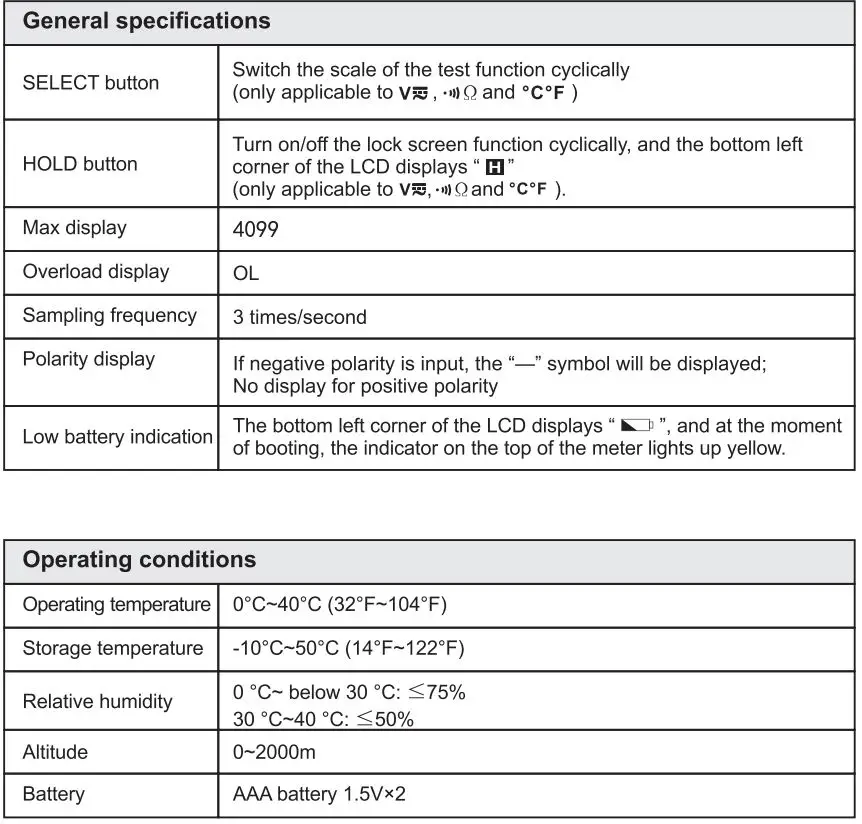


To ensure measurement accuracy, operating temperature should be within 18C-28ºC and the fluctuation range should be within ±1 •c.
Temperature <18°C or >28ºC: Add temperature coefficient error 0.1 x (specified accuracy)/ºC.
6. Maintenance

6.1 General Maintenance
- Clean the meter casing with a damp cloth and mild detergent. Do not use abrasives or solvents!
- If there is any malfunction, stop using the meter and send it for maintenance.
- The maintenance and service must be implemented by qualified professionals or designated departments.
6.2 Battery Replacement (Picture 4)
- * Replace the batteries immediately when the low battery symbol

- Battery replacement: Use a screwdriver to unscrew the screw on the battery cover (top), and remove the cover to replace the batteries. Pay attention to the positive and negative polarity when installing the new batteries.
UNI-T©
UNI-TREND TECHNDLDGV (CHINA) CD., LTD.
No. 6, Gong Ye Bei 1st Road,
Songshan Lake National High-Tech Industrial
Development Zone, Dongguan City,
Guangdong Province, China
Tel: (86-769) 8572 3888
www.uni-trend.com
MODEL Ut123
Part No. P/N:110401108394X

